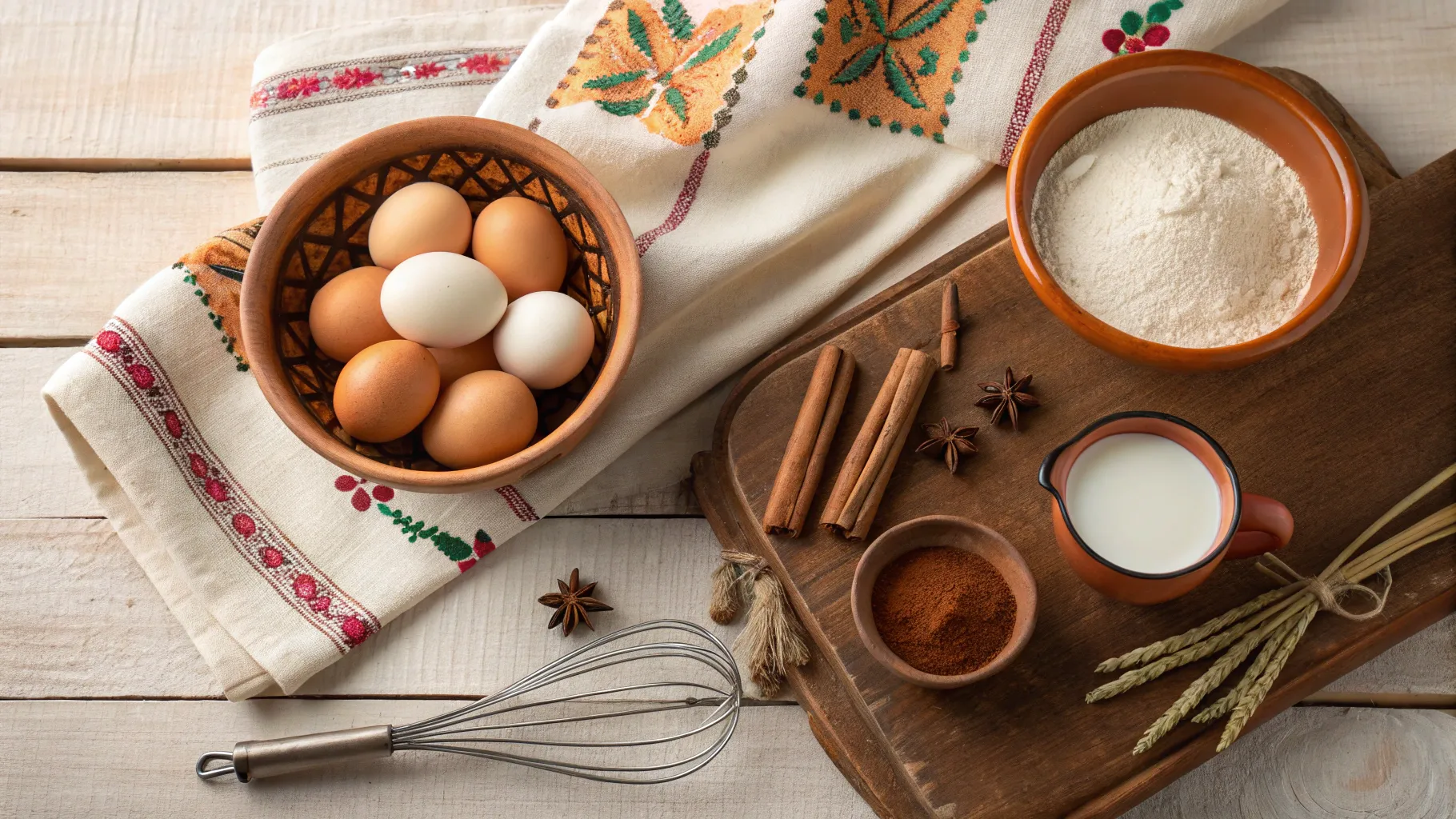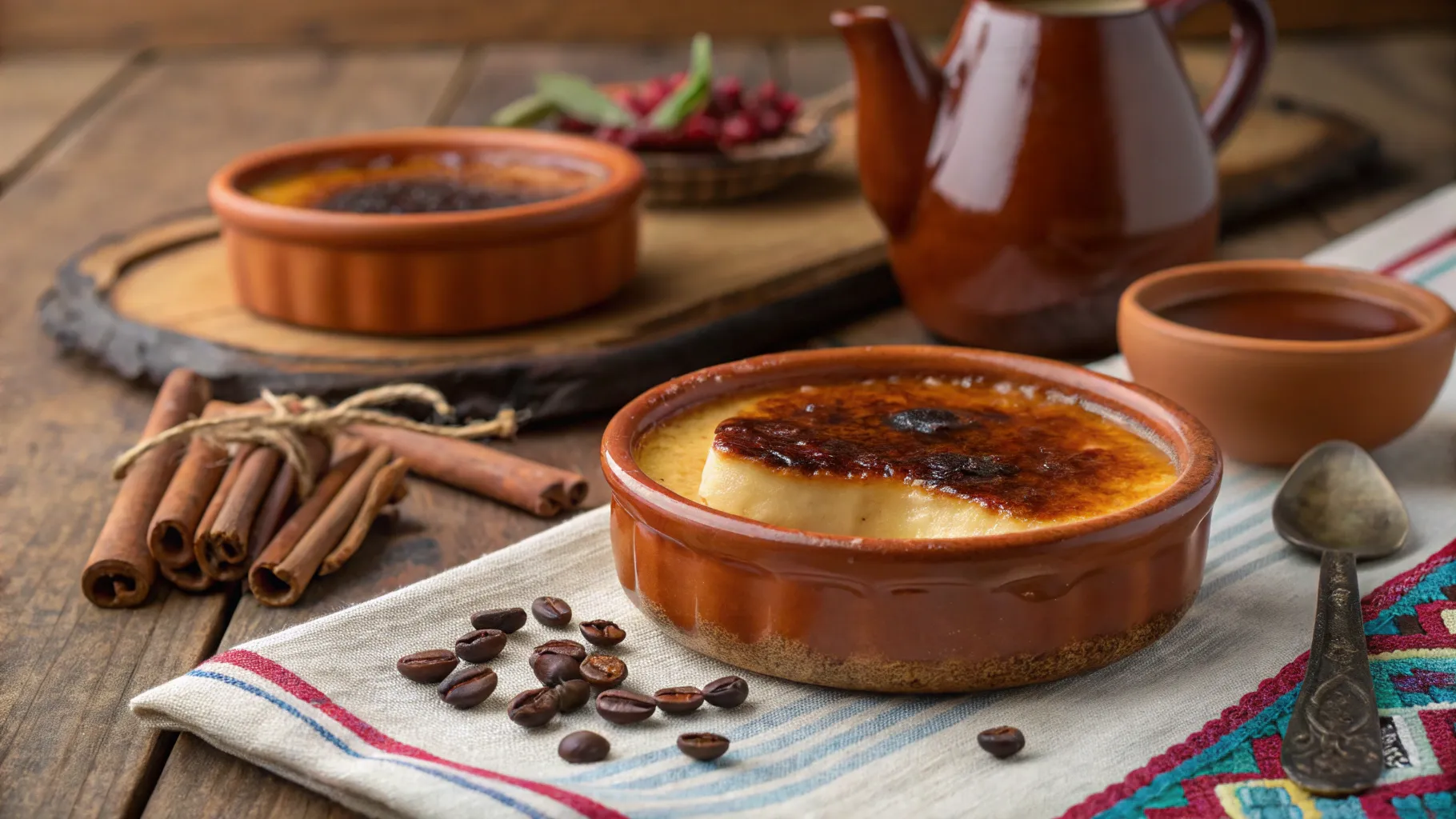Picture yourself wandering through the vibrant streets of Guadalajara on a balmy evening. The air carries whispers of vanilla and cinnamon that guide your steps toward a modest, family-owned eatery. A server approaches with a small clay vessel, its surface kissed with golden caramelization, holding what appears to be custard perfection. Your first taste reveals layers of creamy richness with hints of caramelized sweetness that dance across your palate. You’ve just discovered jericalla—Mexico’s best-kept dessert secret.
This traditional Mexican custard has been winning hearts for generations, yet many people outside of Jalisco remain unfamiliar with its magic. Today, you’ll uncover the mysteries behind this extraordinary dessert and master the techniques that transform simple ingredients into pure culinary bliss.
What Is Jericalla? Understanding Mexico’s Hidden Custard Gem
The Origins and Cultural Significance of Jericalla
Jericalla traces its roots to colonial-era Guadalajara, where Spanish culinary traditions merged with local Mexican ingredients. This beloved dessert emerged from the kitchens of nuns at the Hospicio Cabañas, who created it to nourish children in their care. The recipe spread throughout Jalisco, becoming a cornerstone of regional celebrations and family gatherings.
Unlike its European cousins, jericalla represents a uniquely Mexican interpretation of custard-making. While Spanish settlers brought flan-making techniques, Mexican cooks adapted these methods using locally available ingredients and clay cookware, creating something entirely distinctive.
What Makes Jericalla Different from Other Custard Desserts?
You might wonder how jericalla differs from familiar desserts like flan or crème brûlée. The distinctions are both subtle and significant:

| Dessert | Texture | Caramel Element | Cooking Method | Cultural Origin |
|---|---|---|---|---|
| Jericalla | Creamy yet firm | Caramelized top crust | Baked in clay vessels | Mexico (Guadalajara) |
| Flan | Silky and jiggly | Liquid caramel sauce | Steamed or baked | Spain |
| Crème Brûlée | Rich and creamy | Hard sugar crust | Torch-finished | France |
Jericalla’s texture sits perfectly between the silkiness of flan and the richness of crème brûlée. Its caramelized top provides textural contrast without the liquid caramel layer that defines traditional flan. The traditional clay pot preparation adds earthy undertones that enhance the overall flavor profile.
How Is Jericalla Made? The Complete Guide to Perfect Mexican Custard
Essential Ingredients for Authentic Jericalla
Creating exceptional jericalla requires just six fundamental ingredients. Each component plays a crucial role in achieving the perfect balance of flavors and textures:
| Ingredient | Quantity | Purpose | Selection Tips |
|---|---|---|---|
| Whole Milk | 2 cups | Primary base | Choose full-fat for optimal richness |
| Egg Yolks | 4 large | Thickening agent | Room temperature prevents curdling |
| Granulated Sugar | 1/3 cup + extra | Sweetener and caramelization | Fine granules dissolve more easily |
| Pure Vanilla Extract | 1 teaspoon | Primary flavoring | Avoid imitation for authentic taste |
| Ground Cinnamon | 1/2 teaspoon | Warm spice element | Mexican canela preferred |
| Sea Salt | Pinch | Flavor enhancer | Balances sweetness naturally |
The beauty of jericalla lies in its simplicity. These everyday ingredients transform through careful technique into something extraordinary.
The 3-Step Secret to Perfect Jericalla: Master the Technique
Step 1: Creating the Perfect Custard Base
Your success begins with proper custard base preparation. Heat your milk gently in a heavy-bottomed saucepan until it reaches 180°F—hot enough to see steam rising but not boiling. This temperature ensures optimal flavor extraction from the cinnamon while preventing the proteins from coagulating.
While the milk heats, whisk your egg yolks with sugar until the mixture becomes pale and slightly thickened. This process, called ribboning, creates the foundation for your custard’s luxurious texture.
The critical moment arrives during tempering. Remove your heated milk from the stove and slowly drizzle a small amount into the egg mixture while whisking continuously. This gradual temperature adjustment prevents the eggs from scrambling. Continue adding milk slowly until you’ve incorporated about half, then whisk this mixture back into the remaining milk.
Strain your custard through a fine-mesh sieve to eliminate any lumps or cooked egg bits. This step ensures the silky smooth texture that distinguishes exceptional jericalla. Stir in your vanilla extract and a pinch of salt to enhance all the flavors.
Step 2: The Baking Method That Makes All the Difference
Preheat your oven to 325°F—this moderate temperature ensures gentle, even cooking without curdling. While traditional clay ramekins provide authentic flavor, ceramic or glass custard cups work excellently as alternatives.
Divide your custard among four individual ramekins, filling each about three-quarters full. The water bath technique, known as bain-marie, becomes your secret weapon here. Place your filled ramekins in a large baking dish and carefully pour hot water until it reaches halfway up the sides of your containers.
This water bath serves multiple purposes: it moderates the oven’s heat, prevents overcooking, and ensures uniform temperature distribution. Your jericalla will bake for 45-60 minutes, depending on your ramekin size. Test for doneness by gently shaking a ramekin—the center should have a slight jiggle while the edges remain set.
Step 3: The Signature Caramelized Top
Allow your custards to cool completely before attempting caramelization. This cooling period lets the custard firm up properly, creating the ideal surface for sugar application.
Sprinkle an even layer of granulated sugar across each custard’s surface—approximately one tablespoon per ramekin works perfectly. Position your oven rack about four inches from the broiler element and preheat the broiler on high.
Watch carefully as the sugar transforms. Within 1-2 minutes, it will bubble, melt, and develop that coveted golden-brown caramelization. Remove immediately once you achieve the desired color to prevent burning.
Pro Tips for Perfect Jericalla Every Time
Common Mistakes and Solutions
Temperature Control Issues: Many home cooks rush the heating process, leading to curdled custards. Always use medium-low heat and monitor temperatures carefully.
Grainy Texture Problems: Inadequate straining causes this issue. Pass your custard through a fine sieve twice if necessary to achieve smoothness.
Uneven Caramelization: Distribute sugar evenly and rotate your baking dish if your broiler has hot spots.
Overcooked Centers: The water bath prevents this common problem. Never skip this crucial step.
Creative Variations to Explore
Once you’ve mastered traditional jericalla, consider these exciting variations:
- Chocolate Jericalla: Add two tablespoons of cocoa powder to your milk while heating
- Coconut Version: Substitute half the milk with coconut milk for tropical flair
- Coffee-Infused: Steep ground coffee in your milk for sophisticated depth
- Seasonal Fruit: Fold in pureed strawberries or mango for fruity sweetness
Serving and Storage Guidelines
Serve your jericalla at room temperature or slightly chilled. The contrast between the warm caramelized top and cool custard creates an exceptional sensory experience. Garnish with fresh berries, a sprinkle of cinnamon, or a mint sprig for visual appeal.
Store covered jericalla in your refrigerator for up to three days. For optimal presentation, add the caramelized sugar topping just before serving, as it softens over time.
Nutritional Considerations
Each serving of traditional jericalla contains approximately 245 calories, providing good sources of protein, calcium, and essential vitamins from the eggs and milk. While this dessert is indulgent, its portion size makes it a reasonable treat when enjoyed mindfully.
For dietary modifications, you can substitute coconut milk for dairy-free versions or use sugar alternatives for reduced-calorie options. However, these changes will alter the traditional flavor profile.
The Cultural Experience
Jericalla represents more than just dessert—it embodies Mexican hospitality and tradition. In Guadalajara’s restaurants and street vendors, you’ll find variations that reflect family recipes passed down through generations. Each cook adds their personal touch while respecting the fundamental techniques that define authentic jericalla.
The traditional clay pot presentation isn’t merely aesthetic; these vessels impart subtle earthy flavors that enhance the overall experience. The porous nature of clay also affects the custard’s texture, creating the slightly rustic character that distinguishes jericalla from more refined European custards.
Conclusion
Mastering jericalla connects you with centuries of Mexican culinary heritage while creating moments of pure indulgence. The 3-step secret—perfecting your custard base, mastering water bath baking, and achieving flawless caramelization—transforms simple ingredients into restaurant-quality desserts.
Your journey into jericalla-making begins with understanding that patience and technique matter more than expensive equipment. Each step builds upon the previous one, creating layers of flavor and texture that make this dessert truly special.
Remember, the best jericalla comes from practice and attention to detail. Don’t be discouraged if your first attempt isn’t perfect—even experienced cooks continue refining their technique with each batch.
Ready to create your own jericalla magic? Gather your ingredients, preheat that oven, and prepare to impress your family and friends with this authentic taste of Mexico. Share your jericalla-making adventures in the comments below, and let us know which variations you’re excited to try. Your homemade jericalla awaits—and trust us, that first spoonful will transport you straight to the heart of Guadalajara.

